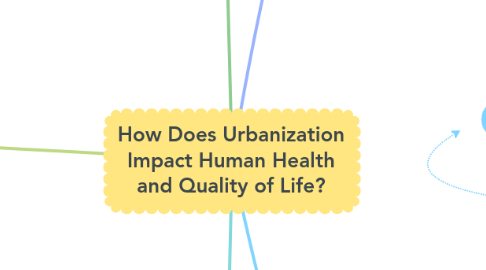
1. Environmental Exposures in Cities
1.1. Air Pollution
1.1.1. Examples
1.1.1.1. Vehicle emissions
1.1.1.2. industrial outputs
1.1.2. Respiratory illnesses
1.1.2.1. asthma
1.1.2.2. COPD
1.1.3. Urban heat island + smog
1.1.4. Solution
1.1.4.1. clean energy, emission standards
1.2. Noise Pollution
1.2.1. Types
1.2.1.1. Traffic, construction, crowding
1.2.2. impacts
1.2.2.1. Stress, sleep disruption, cardiovascular risks
1.2.3. Vulnerable groups
1.2.3.1. children and elders
1.2.4. solution
1.2.4.1. Urban planning for quieter zones
1.3. Light Pollution
1.3.1. Example
1.3.1.1. Artificial lighting
1.3.2. Impacts
1.3.2.1. distrupts circadian rhythms
1.3.2.2. Mental health & sleep disorders
1.3.2.3. affects wildlife behavior
1.3.3. Technological fixes
1.3.3.1. smart lighting
1.4. Chemical & Industrial Contaminants
1.4.1. Example
1.4.1.1. Heavy metals, toxic runoff
1.4.2. impacts
1.4.2.1. Cancer clusters
1.4.2.2. chronic disease
1.4.3. Where
1.4.3.1. Low-income areas
1.4.4. solution
1.4.4.1. Stricter regulations
1.4.4.2. community advocacy
2. Urban Lifestyles & Behaviors
2.1. Physical Inactivity
2.1.1. Causes
2.1.1.1. Car-reliant transport
2.1.1.2. sedentary jobs
2.1.1.3. Lack of safe public spaces
2.1.2. Effects
2.1.2.1. Obesity
2.1.2.2. Cardiovascular disease
2.1.3. Solutions
2.1.3.1. Active design
2.1.3.1.1. Bike lanes
2.1.3.1.2. Pedestrian zones
2.2. Poor Diet & Nutrition
2.2.1. Causes
2.2.1.1. Western fast-food culture
2.2.1.2. NCDs
2.2.1.3. Higher caloric intake
2.2.2. Solutions
2.2.2.1. Education on healthy eating
2.2.2.2. City-level campaigns
2.3. Stress & Mental
2.3.1. Causes
2.3.1.1. Rapid city pace
2.3.1.2. Noise/crowding
2.3.1.3. Shortage of green/natural havens
2.3.2. Impacts
2.3.2.1. Depression
2.3.2.2. Anxiety
2.3.2.3. Burnout
2.3.3. Solutions
2.3.3.1. Community support
2.3.3.2. Mental health policies
2.4. Social Connection
2.4.1. Dense populations
2.4.2. Potential loneliness in “megacities”
2.4.3. Solutions
2.4.3.1. Fostering neighborly ties (communal events)
2.4.3.2. Designing spaces for social interaction
3. Diseases Linked to Urban Pollution
3.1. Heat-Related Illnesses
3.1.1. Example
3.1.1.1. Heatstroke
3.1.1.2. Heat exhaustion
3.1.2. Why
3.1.2.1. Low tree cover
3.1.2.2. Concrete surfaces
3.1.3. Affects most
3.1.3.1. Elderly
3.1.3.2. Homeless
3.1.4. Solution
3.1.4.1. cooling centers
3.1.4.2. urban green space
3.2. Waterborne Diseases
3.2.1. How
3.2.1.1. Inadequate sanitation
3.2.1.1.1. lead to
3.2.1.2. mold build up
3.2.1.2.1. Asthma
3.2.1.3. Industrial runoff
3.2.2. Solution
3.2.2.1. Improved drainage
3.2.2.2. Water treatment
3.3. Respiratory & Cardiovascular Conditions
3.3.1. How
3.3.1.1. Chronic exposure to air pollution
3.3.1.1.1. example
3.3.2. such as
3.3.2.1. Hypertension
3.3.2.2. Heart disease
3.3.2.3. Asthma
3.3.3. Solutions
3.3.3.1. Air quality alerts
3.3.3.2. Cleaner energy
3.3.3.3. traffic control measures
3.4. Cancers & Chronic Diseases
3.4.1. Causes
3.4.1.1. toxic pollutants
3.4.1.2. Heavy metals
3.4.1.3. Lifestyle-related NCDs
3.4.1.3.1. sedentary habits
3.4.2. Affects
3.4.2.1. Elevated rates of lung, bladder, other cancers
3.4.3. Solution
3.4.3.1. Stronger regulations
4. Social & Economic Inequities
4.1. Slum conditions
4.1.1. Overcrowding
4.1.2. suboptimal sanitation
4.1.3. High rates of infectious diseases
4.1.4. Limited infrastructure
4.1.4.1. Such as
4.1.4.1.1. Water
4.1.4.1.2. Electricity
4.1.5. Solution
4.1.5.1. Slum upgrading
4.1.5.2. Equitable planning
4.2. Access to Healthcare
4.2.1. Uneven distribution of hospitals
4.2.2. Socioeconomic barriers
4.2.2.1. example
4.2.2.1.1. cost
4.2.2.1.2. legal status
4.2.3. Migrant/refugee health challenges
4.2.4. Solutions
4.2.4.1. Mobile clinics
4.2.4.2. Outreach programs
4.3. Dietary Issues
4.3.1. Low access to fresh produce
4.3.2. high density fast-food
4.3.3. Solutions
4.3.3.1. local food markets
4.3.3.2. meal programs
4.4. Income & Employment Gaps
4.4.1. Precarious work
4.4.2. Negative Effects
4.4.2.1. Physical health
4.4.2.2. Mental health
4.4.3. Cyclical poverty patterns
4.4.4. Solutions
4.4.4.1. Inclusive economic policies
4.4.4.2. Job training
5. Sustainable Policies & Practices
5.1. Climate Change Adaptation
5.1.1. Heatwave response
5.1.1.1. cool roofs
5.1.1.2. shading
5.1.2. Flood defenses
5.1.2.1. preserving natural buffers
5.1.3. Urban agriculture
5.1.3.1. local food systems
5.1.4. Disaster preparedness
5.1.4.1. early warning
5.2. Social Equity Solutions
5.2.1. Targeted investment
5.2.1.1. marginalized neighborhoods
5.2.2. Universal healthcare coverage
5.2.3. Bridging wealth gaps
5.2.3.1. Progressive taxation
5.2.4. Inclusive governance
5.3. Sustainable Urban Development
5.3.1. Carbon-neutral city plans
5.3.2. Eco-friendly buildings (LEED)
5.3.3. Protecting biodiversity
5.3.3.1. Green corridors
5.3.4. Local climate action
5.3.5. Renewable energy
5.4. Public Engagement & Education
5.4.1. Environmental literacy
5.4.2. School nutirition programs
5.4.3. NGO and government partnerships
5.4.4. Transparent data
5.4.4.1. city-level health metrics
